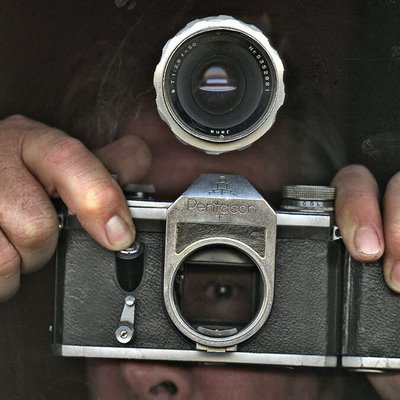
In 1959 Brother Emmett who was in charge of the St Ed's school bookstore and the mail kept nodding negatively every time I passed to enquire if I had a package. But one day (I remember it was very hot so it must have been an early Austin, Texas spring) he nodded positively and handed me a big and quite heavy package. Inside was the most beautiful glossy box I had ever seen. From it I pulled out my first serious camera, a Pentacon-F with an f-2.8 50mm Zeiss Tessar lens. The package had come from Olden Cameras in New York City. I had purchased an Agfa sillette the year before on a trip to Wahsington DC. The only two things both cameras had in common was that were German and they were shiny. This era, the 50s, is sometimes called the photographic chrome age.

Holding the Pentacon-F was magic. The world was there for me to capture (in a 50s sense of the word not in the modern digital capture meaning) and to control. I immediately felt frustrated when I found out that my Spanish teacher, Brother Anton had the same camera but with a superior and faster 58mm Zeiss Biotar. Within a year Brother Edwin, who taught me religion and forced me to learn to play the alto saxophone in the school band had purchased a new-fangled Japanese Konica.
More insult was added with furtherinjury, that Christmas when I was in Mexico City. My Uncle Tony showed up with an exotic camera I had never heard of called a Nikon SP. He told me my East German Pentacon was junk and that the future of cameras was in Japan. I was too respectful to point out that he was full of ...But the damaging seeds of doubt began to slip into my mind. I felt terrible. Then my friend Howard Houston from Austin came to visit me in 1961.He brought a Miranda Reflex that had all kinds of refinements and a faster lens. I was plain jealous.

I went to the Monte de Piedad, the Mexico City government pawn shop and spotted Mirandas that were all well over my budget. It was in Foto Rudiger, On Venustiano Carranza Street, downtown that I finally found a roughed up Pentax S-3 with a semi-automatic F-2 lens and, low and behold, with an innovation that was called an instant return mirror.

These cameras and even the "more recent" ones of my working collection like a heavy, black and serious looking Nikon F-3 with a huge motor drive that has more torque than a Toyota Prius, have a feel, a look, a beauty that the modern cameras do not have. It may have something to do with the fact that I sometimes think in Spanish. in Argentina plastic was always rendered as material plástico. It sounded and still sound cheap.
But I think there is another element here. I remember being able to open the doors of 50s vintage Chevrolets, Buicks and Oldsmobiles. On the sill you could read a beautiful stamp on the metal that said Body by Fisher. There was a pride in the ownership of such a car. My wife's Audi lacks that mystique even if it is a darn better car than those Bodies by Fishers from the Chrome Age.
Who can forget the look of the all black Canon F-1? It had the look of a modern Hummer except it seemed more authentic in its apparent beefy indistructability.
Things began to change for the worse when Olympus started selling units that featured ESP! Iamgine losing control to your mother-in-law. That's what ESP meant.
Now the image of a modern photographer is not of one looking through his or her camera to take a picture but of one looking at the back of it with a puzzled look.
Not too long ago a distinguished gentleman of a premier car dealership reacted to my comment of wanting to look under the hood of an Aston Martin. "There is nothing underneath, " he said, sadly, "It is just a Ford engine."
The magic of my East German Pentacon, the Pentax S-3, my Nikon FM-2s, the venerable F-3 is still in them. I can feel it when I hold them. The world still feels conquerable. But when I look at what cameras have become the seem to be Aston Martins with Ford Engines.
That Pentax S-3 still works as does my first, untarnished, but faded first love, My Pentacon F. Paul Leisz, my Hungarian bus driver friend came over on Sunday. He took pictures of my plants with his mildly expensive Nikon DSLR (digital single lens reflex). The pictures were all over-exposed. I metered the scene with my formerly state-of-the-art Minolta Flash Meter VF. I gave Paul the correct setting for his camera and told him to put it in manual. When he did the camera did not fire. "It will not allow me to take a picture because it thinks it is the wrong exposure." Imagine that! His mother-in-law is in control.






